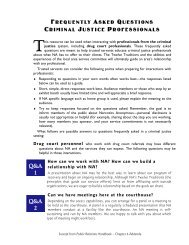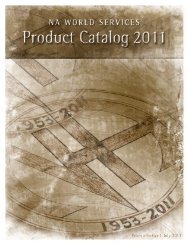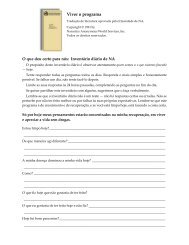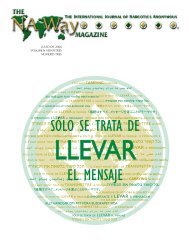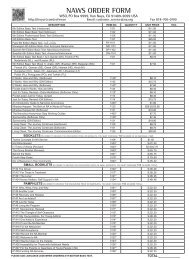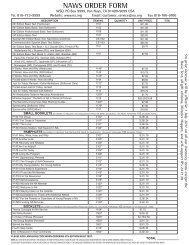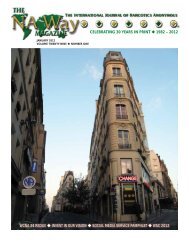Public Relations Handbook - Narcotics Anonymous
Public Relations Handbook - Narcotics Anonymous
Public Relations Handbook - Narcotics Anonymous
You also want an ePaper? Increase the reach of your titles
YUMPU automatically turns print PDFs into web optimized ePapers that Google loves.
e used and adapted to form relationships with criminal-justice systems all over theworld. Members can also adapt these principles and ideas to fit different types offacilities, such as correctional vocational centers and maximum-security institutions.The challenge is to build relationships that honor NA’s principles and the facility’srules. Areas may want to seek experience and support from local regions, zonalforums, or NA World Services.P l a n n i n g a n d p r e p a r a t i o n f o r a r e a s a n d c o m m i t t e e sCommittee preparation and trainingClear training methods can help a committee have a positive, long-lasting relationshipwith correctional facilities. Members should be accountable to a committee whenestablishing relationships with the criminal-justice system. The following items can help acommittee that is planning to enter (or that has already established) a relationship withcorrectional facilities. Prior to initiating a relationship, the committee has a pool of trusted servantswho are willing to be of service. Considering how many members in the areaare typically willing to take service positions can help a committee decide howfrequently NA will interact with a facility. Trusted servants need to be realisticabout the area’s ability to provide service to a facility over time. The committee has created a written document for trusted servants thatclarifies and communicates the rules of the correctional facility and theguidelines of the committee. Sometimes NA guidelines are different from afacility’s rules; be sure to establish guidelines that honor both the institution’srules and NA’s principles. The committee informs members that there can be challenges in filling outclearance forms. Clearance forms take time to process and can sometimesrequire fingerprinting or background investigations. A member is notautomatically guaranteed clearance into a facility just because they fill out a form. If a trusted servant cannot fulfill a commitment to a facility, then another of thecommittee can show up in their absence. If clearance is required for all trustedservants entering a facility, then the committee will want to have both memberscleared and have made prior arrangements for the other member to act as asubstitute, if needed; if no one is able to fulfill the commitment, then thetrusted servant should inform the facility. The committee regularly reviews and updates guidelines or training tools.Trusted servants may want to read portions of their guidelines aloud at eachmeeting to ensure all trusted servants stay informed. Learning days held on aregular basis can also provide members with training. Clean-time requirements for sharing on panels are established and followed. The committee ensures that there is regular communication between the facilitycontact person and the NA member coordinating meetings for that facility. If the issue of panel leaders or members taking medication comes up, then thepanel leader or committee member can refer to In Times of Illness for guidance.This issue is often best left between the member, their sponsor, and their HigherPower. In our public relations service, we may limit the participation of memberson certain medications. We do this because we do not want the NA program tobe misrepresented. We are a program of complete abstinence, but we want to beinclusive, so we treat these situations sensitively by taking members aside andsharing our own experience with medication and living drug-free.October 2006 | PR <strong>Handbook</strong> | 51





